
Mir Qamar-ud-din Khan Siddiqi also known as Chin Qilich Qamaruddin Khan, Nizam-ul-Mulk, Asaf Jah and Nizam I, was the first Nizam of Hyderabad.

Mirza Nasir-ud-Din Muḥammad Shah was the thirteenth Mughal emperor from 1719 to 1748. He was son of Khujista Akhtar, the fourth son of Bahadur Shah I. After being chosen by the Sayyid Brothers of Barha, he ascended the throne at the young age of 16, under their strict supervision.
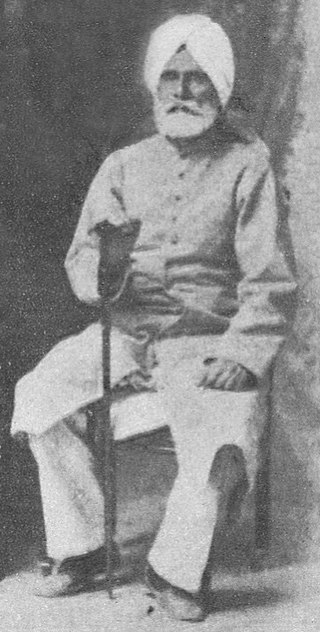
Altaf Hussain Hali, also known as Maulana Khawaja Hali, was an Urdu poet and writer.
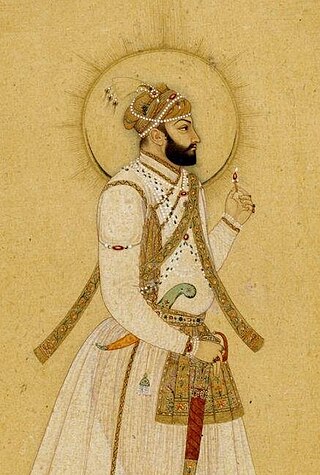
Farrukhsiyar, also spelled as Farrukh Siyar, was the tenth Mughal Emperor from 1713 to 1719. He rose to the throne after deposing his uncle Jahandar Shah. He was an emperor only in name, with all effective power in the hands of the courtier Sayyid brothers. He was born during the reign of his great-grandfather Aurangzeb, as the son of Azim-ush-Shan and Sahiba Niswan. Reportedly a handsome man who was easily swayed by his advisers, he was said to lack the ability, knowledge and character to rule independently. He was executed by Maharaja Ajit Singh of Marwar.

The Battle of Karnal was a decisive victory for Nader Shah, the founder of the Afsharid dynasty of Iran, during his invasion of India. Nader's forces defeated the army of Muhammad Shah within three hours, paving the way for the Iranian sack of Delhi. The engagement is considered the crowning jewel in Nader's military career as well as a tactical masterpiece. The battle took place near Karnal in Haryana, 110 kilometres (68 mi) north of Delhi, India.

Mirza Aziz-ud-Din Muhammad, better known by his regnal name Alamgir II, was the fifteenth Mughal emperor from 1754 to 1759. He was the son of Jahandar Shah.

Mir Muhammad Taqi, known as Mir Taqi Mir, was an Urdu poet of the 18th century Mughal India and one of the pioneers who gave shape to the Urdu language itself. He was one of the principal poets of the Delhi School of the Urdu ghazal and is often remembered as one of the best poets of the Urdu language. His pen name (takhallus) was Mir. He spent the latter part of his life in the court of Asaf-ud-Daulah in Lucknow.
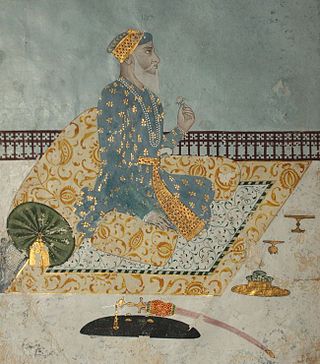
Saadat Khan Nishapuri was the first Nawab of Kingdom of Awadh from 26 January 1722 to 1739 and the son of Muhammad Nasir. At age 25, he accompanied his father on the final campaign of the Mughal Emperor Aurangzeb against the Marathas in the Deccan, and the emperor awarded him the title of Khan Bahadur for his service.
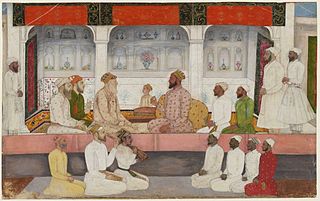
The Sayyid brothers were Syed Hassan Ali Khan Barha and Syed Hussain Ali Khan, two powerful Mughal nobles during the decline of the empire.
Qazi Ghulam Mustafa was one of the prominent noblemen during the Mughal empire. He was entitled 'Kartalab Khan' by Bahadur Shah I. He was Emir and belonged to Ferozepur Jhirka.
Ali Asghar was one of the prominent Emir and nobleman during the Mughal empire. He was entitled 'Khan Zaman Khan Bahadur' by Emperor Farrukhsiyar. He remained in many important posts during the successive rules of Bahadur Shah I, Jahandar Shah, Farrukhsiyar, Rafi ud Darajat, Shah Jahan II and Muhammad Shah.
Islam Khan V was one of the prominent Emir and nobleman during the Mughal empire. He was titled "Islam Khan" and "Barkhurdar Khan" by Emperor Bahadur Shah I and held many important posts during the successive rules of Bahadur Shah I, Jahandar Shah, Farrukhsiyar, Rafi ud Darajat, Shah Jahan II and Muhammad Shah.
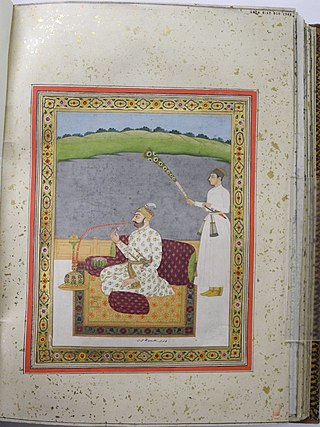
Nawab Sayyid Hassan Ali Khan Barha, also known as Qutub-ul-Mulk, Nawab Sayyid Mian II, Abdullah Khan II, was one of the Sayyid brothers, and a key figure in the Mughal Empire under Farrukhsiyar.
Persian people were one of the major ethnic groups, who accompanied the ethnic Turco-Mongol ruling elite of the Mughal Empire after its invasion of the Indian subcontinent. Throughout the Mughal Empire, a number of ethnic Persian technocrats, bureaucrats, traders, scientists, architects, teachers, poets, artists, theologians and Sufis migrated and settled in different parts of the Indian Subcontinent.

Roshan-ud-Daulah, known by his original name Khwaja Muzaffar Panipati and the title of Turra-i-Baz Roshan-ud-Daulah Zafar Khan, was the Grand Vizier of the Mughal Empire during the reign of Muhammad Shah. He was known by the nickname Turra-i-Baz(falcon's crest) as Roshan-ud-Daula and all his men wore their turbans in the same way, with an end sticking out.
Hidayatullah Khan was the Grand Vizier of Bahadur Shah I.
The Ansaris of Panipat are descended from Khwaja Abdullah Pir of Herat, one of whose descendants settled in Panipat, which was a centre of learning and was already famous for its Mashaikh and Auliya.
Munim Khan II was the Grand Vizier of the Mughal Empire during the reign of Mughal emperor Bahadur Shah I.
Sayyid Salabat Khan Zulfiqar Jang was a Mughal noble of Kashmiri descent and the Mir Bakhshi and Amir-ul-Umara of Ahmad Shah Bahadur.
Inayatullah Kashmiri was a prominent Mughal noble of Kashmiri descent in the early 1700s, in the position of the Diwan-i-Tan-o Khalisa.














